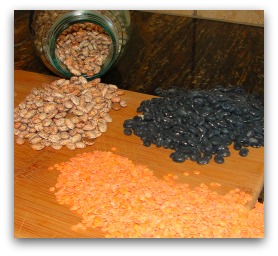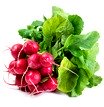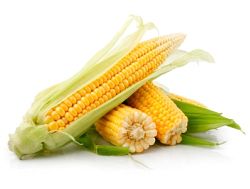Vegetarian Protein Sources —
Legumes and Grains to the Rescue!

Excellent vegetarian protein sources, legumes and
grains also score highly for fiber, folate, and vitamin B. And more good
news: despite their low fat content, they taste remarkably good when prepared with a little thought and imagination. Let's look at legumes first...
Legumes
Among the more-common legumes are lentils; pinto, black, and kidney beans; mung, navy, and lima beans. But there are many, many others as well: adzuki,
butter, and calico beans; cannellini, great northern, and soy beans;
edamame; garbanzos; black-eyed and split peas...not to mention the
fabulous scarlet runner bean! Just for starters. Click here for a broader description of beans.
Most legumes provide between 5 and 8 grams of protein per half cup (cooked), although the protein content of soybeans is higher. [For some helpful tips on soaking legumes, see this page at Sense and Serendipity, where Divina discusses ways to disarm "oligosaccharides," the sugar molecules that can lead to flatulence.]
Generally speaking, legumes tend to be delicious
even when quite simply prepared. And if you get a little creative
and/or adventuresome, they sometimes taste better still. Pasta e
fagioli, southwestern black bean soup, refried pinto beans with some embellishment...any of these are wonderful, and there are so many more. In fact, would you believe black-bean brownies? Check 'em out!
General Note: Please be sure your beans are cooked thoroughly before you eat them!
Grains
Whole grains, which contain the entire kernel (bran, germ, and endosperm), are another nutritious food, whether or not you're vegetarian/vegan. [If you're gluten intolerant, however, you'll want to avoid wheat, barley, and rye.] Here are some of your choices:
- brown rice (For a cool way to cook brown rice, check out this page.)
- buckwheat
- bulgur (cracked wheat)
- oatmeal
- popcorn
- whole grain barley
- whole grain cornmeal
- whole rye and wheat
- wild rice
- millet
- amaranth
- quinoa
- sorghum
- triticale
Toss any of these into salads, or use them as
a base for casseroles or as a "nest" for stir-fries or sauces; even eat
them by themselves. Cooked wheat or oat groats, for example, make a terrific
breakfast cereal, as do sautéed steel-cut oats (pre-cooked) and quinoa,
which weighs in at 8 grams of protein per 6.5-ounce serving.
Really, your options are virtually endless with grains; you
just need to use a little imagination...and planning ahead can be useful, as well, as grains take a while to cook. To fully access the protein from
your grains, some nutritional experts advise mixing them with legumes or another protein source. And vice versa.

Although the turtle and I have conducted an oddly fruitless online search for a good real-time protein counter, perhaps you’ll have better luck yourself. I hope so. If not, this book of "food counts" might do the trick for now. It's the one I use myself.
Meanwhile, something to remember with vegetarian
protein is that the grams do add up. Not as quickly as animal protein, obviously,
but in the same way. With a little planning and foresight, you can do
quite well with vegetarian protein sources such as these: seeds/nuts,
dairy, soy products, seitan, and even veggies. Enjoy the ride!
And if you want some veggie burgers on that ride, click here!
Please understand that the material at this site is NOT medical advice, as I am neither doctor nor nutritionist. What I am is merely someone who's lived successfully on a vegetarian diet for many decades...and I transitioned from omnivore to vegetarian gradually. Do check with your doctor, though, if you're considering big changes to your own diet. Also, be sure to find a dependable source of Vitamin B12.
Living Vegetarian the Easy Way
Copyright 2010-2024. Lynda Edwards. All rights reserved.



